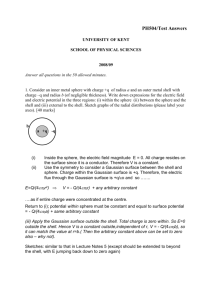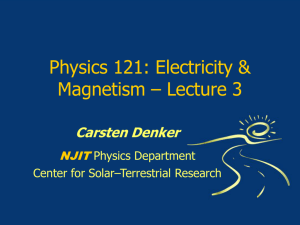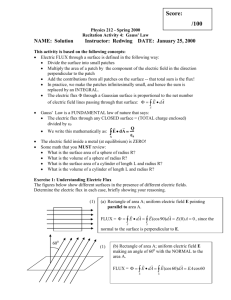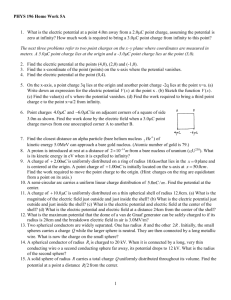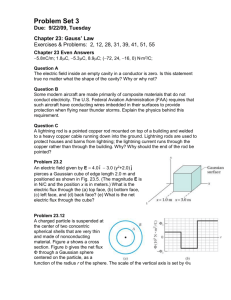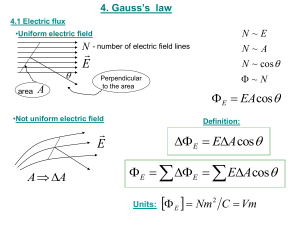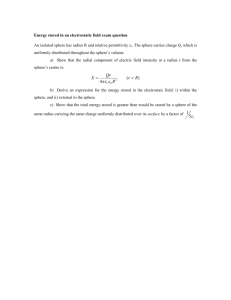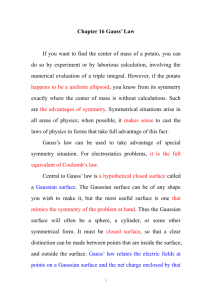Chapter 23: Gauss* Law
advertisement
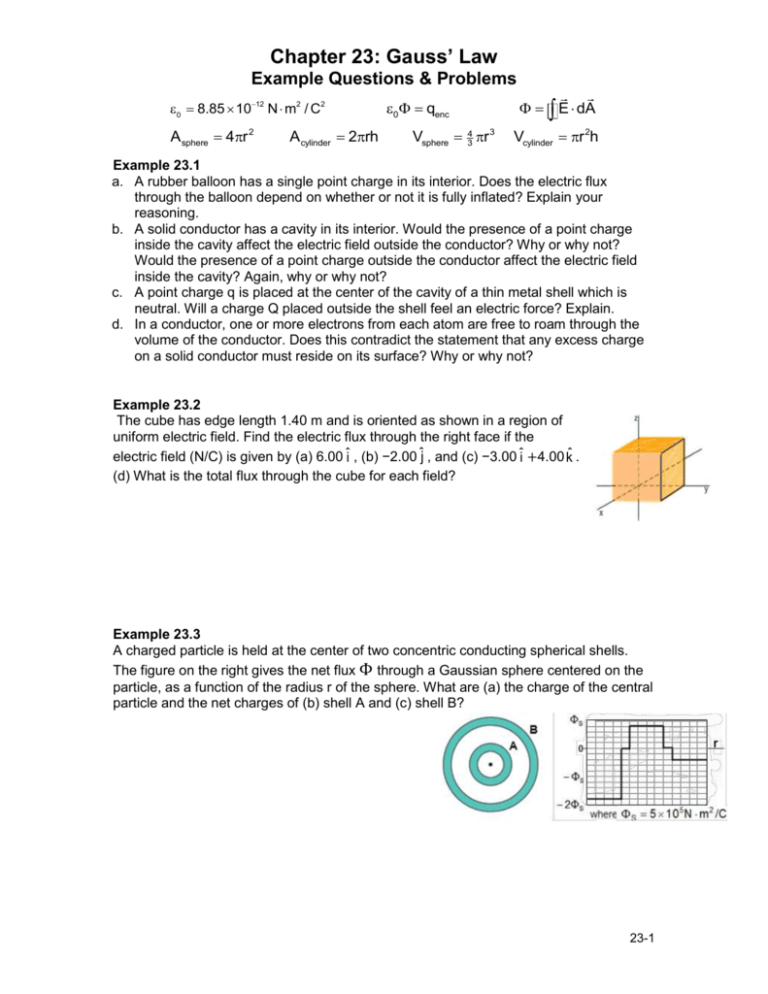
Chapter 23: Gauss’ Law Example Questions & Problems 0 8.85 1012 N m2 / C2 A sphere 4r 2 A cylinder 2rh 0 qenc Vsphere 34 r 3 E dA Vcylinder r 2h Example 23.1 a. A rubber balloon has a single point charge in its interior. Does the electric flux through the balloon depend on whether or not it is fully inflated? Explain your reasoning. b. A solid conductor has a cavity in its interior. Would the presence of a point charge inside the cavity affect the electric field outside the conductor? Why or why not? Would the presence of a point charge outside the conductor affect the electric field inside the cavity? Again, why or why not? c. A point charge q is placed at the center of the cavity of a thin metal shell which is neutral. Will a charge Q placed outside the shell feel an electric force? Explain. d. In a conductor, one or more electrons from each atom are free to roam through the volume of the conductor. Does this contradict the statement that any excess charge on a solid conductor must reside on its surface? Why or why not? Example 23.2 The cube has edge length 1.40 m and is oriented as shown in a region of uniform electric field. Find the electric flux through the right face if the electric field (N/C) is given by (a) 6.00 î , (b) −2.00 ĵ , and (c) −3.00 î +4.00 k̂ . (d) What is the total flux through the cube for each field? Example 23.3 A charged particle is held at the center of two concentric conducting spherical shells. The figure on the right gives the net flux Φ through a Gaussian sphere centered on the particle, as a function of the radius r of the sphere. What are (a) the charge of the central particle and the net charges of (b) shell A and (c) shell B? 23-1 Example 23.4 A section of a conducting rod of radius R1 = 1.30 mm and length 11.00 m inside a thin-walled coaxial conducting cylindrical shell of radius R2 = 10.0R1 is shown. The net charge on the rod is q = +3.40 × 10-12 C; that on the shell is −2.00q. (a) What are the charges on the interior and exterior surface of the shells? (b) Plot E(r) vs. r and explain you plot using short concise sentences. What are the magnitude and direction of the electric field at (c) r = 2.00R2 and (d) r = 5.00R1? Example 23.5 A solid insulating sphere of radius R = 5.60 cm has a nonuniform charge distribution of ρ = (1.41 nC/m3)r/R, where r is the radial distance from the sphere’s center (a) What is the sphere’s total charge? (b) What is the magnitude E of the electric field at (i) r = 0, (ii) r = R/2, (iii) r = R? (c) Sketch a graph of E versus r. 23-2 Example A When a shower is turned on in a closed bathroom, the splashing of the water on the bare tub can fill the room's air with negatively charged ions and produce an electric field in the air as great as 1000 N/C. Consider a bathroom with dimensions 25m × 3.0m × 2.0m. Along the ceiling, floor, and four walls, approximate the electric field in the air as being directed perpendicular to the surface and as having a uniform magnitude of 600 N/C. Also, treat those surfaces as forming a closed Gaussian surface around the room's air. What are (a) the volume charge density ρ and (b) the number of excess elementary charges e per cubic meter in the room's air? Solution a. The total surface area bounding the bathroom is A 2 2.5 3.0 2 3.0 2.0 2 2.0 2.5 37 m2 . The absolute value of the total electric flux, with the assumptions stated in the problem, is | | | E A | | E | A (600 N/C)(37 m2 ) 22 103 N m2 / C. By Gauss’ law, we conclude that the enclosed charge (in absolute value) is |qenc| = 0 || = 2.0 × 10–7 C . Therefore, with volume V = 15 m3, and recognizing that we are dealing with negative charges, the charge density is | q | 2.0 107 C enc 1.3 108 C/m3 . 3 V 15 m b. We find (|qenc|/e)/V = (2.0 × 10–7 C/1.6 × 10–19 C)/15 m3 = 8.2 × 1010 excess electrons per cubic meter. Example B A nonconducting spherical shell of inner radius a = 2.00 cm and outer radius b = 2.40 cm has (within its thickness) a positive volume charge density = A/r, where A is a constant and r is the distance from the center of the shell. In addition, a small ball of charge a = 45.0fC is located at that center. What value should A have if the electric field in the shell (a ≤ r ≤ b) is to be uniform? Solution To find an expression for the electric field inside the shell in terms of A and the distance from the center of the shell, select A so the field does not depend on the distance. We use a Gaussian surface in the form of a sphere with radius rg, concentric with the spherical shell and within it (a < rg < b). Gauss’ law will be used to find the magnitude of the electric field a distance rg from the shell center. The charge that is both in the shell and within the Gaussian sphere is given by the integral qS = ∫dV over the portion of the shell within the Gaussian surface. Since the charge distribution has spherical symmetry, we may take dV to be the volume of a spherical shell with radius r and infinitesimal thickness dr: dV = 4r2 dr. Thus, r r r A 2 qs 4 r 2dr 4 r dr 4 A r dr 2 A rg2 a 2 . a a a r The total charge inside the Gaussian surface is q qs q 2 A rg2 a2 . g g g The electric field is radial, so the flux through the Gaussian surface is = 4 rg2 E, where E is the magnitude of the field. Gauss’ law yields 4p0Erg2 q 2p A rg2 a2 . We solve for E: 23-3 1 q 2pAa2 2 2p A . 4p0 rg rg2 For the field to be uniform, the first and last terms in the brackets must cancel. They do if q q – 2Aa2 0 A 1.79 10 11C / m2 A 2a2 a 2.0010152 m E q 45.010 C 23-4


